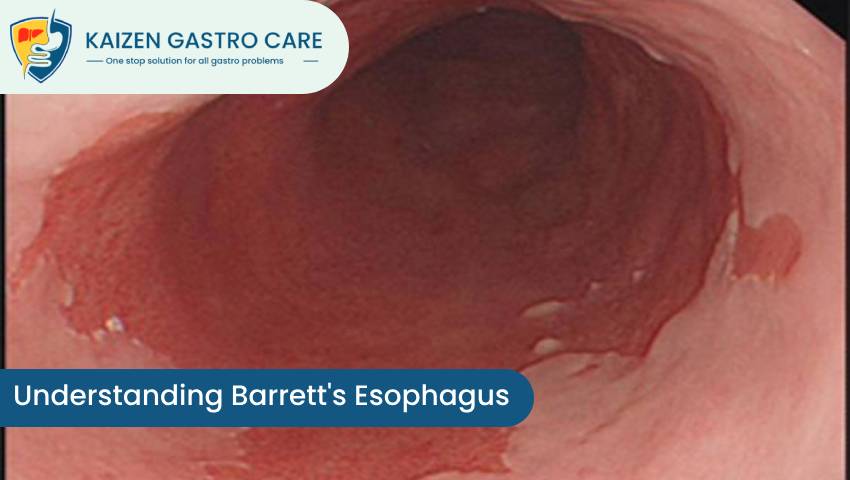
- 19/06/2023
- Kaizen Gastro Care
- 0 Comments
- Digestive Disorder
Understanding Barrett’s Esophagus
Barrett’s esophagus is a condition that affects the lining of the esophagus, the tube that joins the throat to the stomach. It is a serious disorder that develops as a result of chronic gastroesophageal reflux disease (GERD). In this blog, we will delve into the causes, symptoms, and treatment options for Barrett’s esophagus to help you gain a better understanding of this condition.
What is Barrett's Esophagus?
Barrett’s esophagus is a condition characterized by abnormal changes in the cells lining the lower part of the esophagus. It occurs when the normal scaly cells are replaced by a type of cell called columnar cells, similar to those found in the intestines. This difference in cell type is a defense mechanism in response to chronic acid reflux, but it also raises the risk of developing esophageal cancer.
Who gets Barrett's esophagus?
People who are more likely to develop Barrett’s esophagus:
- Individuals over the age of 50
- Men are more likely to develop Barrett’s esophagus than women.
- Excess weight and obesity
- Having a family history of Barrett’s esophagus
- Caucasian ethnicity
- Smoking
What causes Barrett's esophagus?
The primary cause of Barrett’s esophagus is GERD, a disorder in which stomach acid flows back into the esophagus, causing irritation and inflammation. However, not everyone with GERD develops Barrett’s esophagus. Certain factors that improve the risk include:
- Chronic and severe GERD symptoms
- Long-standing history of acid reflux
- Obesity
- Smoking
- Male gender
- Age (typically over 50 years old)
What are the symptoms of Barrett's esophagus?
Barrett’s esophagus itself does not cause noticeable symptoms. Instead, signs are usually related to GERD, including:
- Frequent heartburn
- Acid regurgitation
- Difficulty swallowing
- Chest pain
- Chronic cough or hoarseness
- Involuntary weight loss
- Blood in stool
- Sense of food stuck in your esophagus
It’s essential to monitor these symptoms and seek medical attention if they persist or worsen.
How is Barrett's esophagus diagnosed?
If Barrett’s esophagus is suspected, Kaizen experts Dr. Vikrant Kale & Dr. Samrat Jankar may recommend further testing such as:
- Upper endoscopy: A light, flexible tube with a camera is passed through the mouth and into the esophagus to examine the lining for abnormalities.
- Biopsy: During an endoscopy, small tissue samples are taken for examination to confirm the presence of Barrett’s esophagus.
- Imaging tests: Additional tests like barium swallow or esophageal manometry may be used to assess the extent of the disease.
What are the complications of Barrett's esophagus if untreated?
Barrett’s esophagus itself is considered a premalignant condition, meaning it improves the risk of developing esophageal adenocarcinoma, a type of cancer. However, it’s important to note that not all people with Barrett’s esophagus will develop cancer. Routine monitoring and earlier detection are crucial to controlling the disease and preventing cancerous changes.
How is Barrett's esophagus treated?
The main purpose of treating Barrett’s esophagus is to manage the underlying GERD and reduce the risk of esophageal cancer. Some common treatment options include:
- Lifestyle Modifications:
- Dietary changes: Avoiding trigger foods, such as spicy or sour foods, and swallowing smaller, more frequent meals.
- Weight management: Maintaining a healthy weight to ease pressure on the stomach and lower esophageal sphincter.
- Elevating the head of the bed: Sleeping with the upper body elevated can assist prevent stomach acid from flowing into the esophagus during sleep.
- Medications:
- Proton pump inhibitors (PPIs): These drugs decrease the production of stomach acid and can help relieve symptoms and boost healing of the esophagus.
- H2 receptor blockers: These medicines decrease the production of stomach acid and provide relief from GERD signs.
- Endoscopic Treatments:
- Radiofrequency ablation (RFA): This method uses heat energy to destroy abnormal cells in the esophagus and promote the growth of normal, healthy cells.
- Cryotherapy: Liquid nitrogen or extremely cold gases are used to freeze and destroy abnormal cells.
- Surgical Interventions:
In some cases, surgery may be recommended to manage Barrett’s esophagus and GERD. This option is usually considered when other treatments have been ineffective or if there is a high risk of developing esophageal cancer. - Regular Monitoring and Follow-up: If diagnosed with Barrett’s esophagus, it is important to undergo regular surveillance endoscopies. These techniques help monitor the progression of cell changes and detect any symptoms of dysphasia or cancer at an early stage, allowing for timely intervention.
How can I prevent Barrett's esophagus?
While it may not be possible to completely prevent Barrett’s esophagus, you can take steps to decrease your risk and manage the underlying diseases that contribute to its development. Here are some measures that may help:
- Manage gastroesophageal reflux disease (GERD)
- If you smoke, quitting is highly recommended
- Adopting a healthy lifestyle that includes regular exercise and a balanced diet can aid achieve and maintain a healthy weight.
- Eating a diet rich in fruits, vegetables, whole grains, and lean proteins may be helpful.
- If you have chronic acid reflux or a family history of Barrett’s esophagus, it’s important to undergo routine check-ups and screenings.
Conclusion:
Understanding Barrett’s esophagus is important for people experiencing symptoms of GERD and for those who are at risk due to chronic acid reflux. Immediate diagnosis and appropriate treatment can help manage the condition effectively, decreasing the risk of complications, including the development of esophageal cancer.
If you suspect you may have Barrett’s esophagus or are experiencing persistent GERD symptoms, it is important to consult with Kaizen Gastro Care, the best Gastroenterology Clinic in Pune, Maharashtra for an accurate diagnosis, monitoring, and personalized treatment plan.
